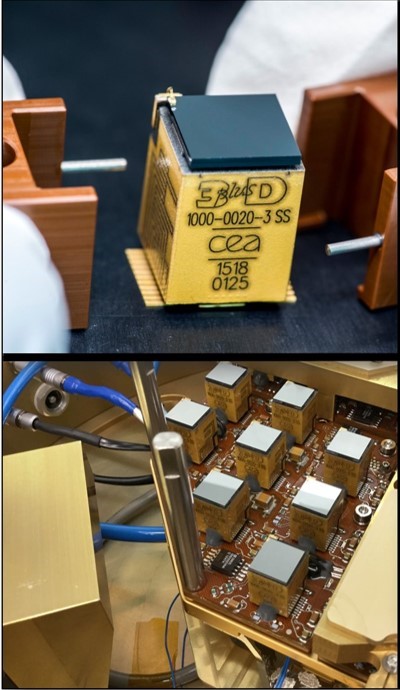For about fifteen years, the teams of the CEA's Fundamental Laws Research Institute and 3D PLUS, a company based in the Paris region, have learned to work closely together at the best international level to push the limits of high energy (2 - 1000 keV) spectro-imager performance for space applications. These are hard X-ray and finely pixelized gamma-ray detectors based on semiconductors (cadmium telluride CdTe) read by low-noise microcircuits designed specifically for Irfu and assembled in miniature hybrid components, weighing only 4 grams, made with the company's 3D PLUS integration technology.
To promote the development and applications of this technology, the result of a cooperation between research and industry, and to continue enriching this unique know-how, CEA-Irfu and 3D PLUS have just created a joint laboratory, ALB3DO (Advanced Laboratory for 3D Detection Device Developments).
The scientific objectives of the joint laboratory are twofold: realize in the short term a very high performance portable gamma camera demonstrator, with a first prototype available from 2022, and conduct research for the development of new X and gamma detectors with very high pixel density. Located at the CEA Paris Saclay center as well as at 3D PLUS at BUC, ALB3DO will start welcoming physicists, engineers, technicians, PhD students and trainees involved in this project, including five new employees, from the end of 2020. Within 5 years this activity should involve around 30 employees.
For high energy astronomy, the Caliste detectors were a revolution: thanks to their pixelization, these instruments, real digital cameras with hard X-rays and gamma rays embarked on satellites, bring an image quality, a precision of dating of events, a sensitivity and a precision of measurement of the energy of each photon never reached before.
From this collaborative work between research and industry were born several generations of X and gamma detection modules. The latest one, which has been qualified for space, equips the focal plane of the STIX instrument on board the ESA (European Space Agency) Solar Orbiter space mission. Launched from Cape Canaveral in February 2020, Solar Orbiter is dedicated to the study of the sun.
The unique characteristics of the Caliste modules make it possible to imagine numerous applications outside the field of astrophysics. 3D PLUS and the CEA (French Atomic Energy Commission) have therefore studied the evolutions to be brought to this technology for a higher volume use in industrial fields such as nuclear control.
Within the ALB3DO joint laboratory, 3D PLUS and the CEA join as partners to promote the development of the technology:
- in the sector of radiation monitoring in the nuclear field with the prospect of realizing a high performance portable gamma camera demonstrator allowing to locate and identify radioactive sources, by measuring their energy levels. These data will be visualized in real time on a screen. This equipment will thus be able to meet the needs of various nuclear applications such as the monitoring of radioactive leaks, radioactive waste management or dismantling. This is an important technological advance for the safety of people, enabling the improvement of the practices of radiation protection services, and the protection of workers exposed to ionizing radiation in nuclear power plants.
- in the space astronomy sector by continuing to develop new high-performance spectroimagers based on the most innovative 3D PLUS integration technologies.
Contact Irfu : Olivier Limousin






